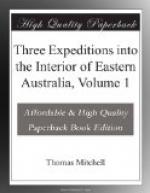We placed the grilled snake, as it seemed quite cooked, within the wooden bowl, and we left also a head-band (uluguer) which we had found near the fire, and we then continued our journey up the mountains. This range consisted of a different rock from any I had seen in the country, a chocolate-coloured trapean conglomerate. A very dark colour distinguished these rocky masses, which terminated in pointed obelisks, or were broken into bold terraces of dismal aspect. In the little stream were many pebbles of vesicular trap, probably an amygdaloid with the kernels decomposed, but containing particles of olivine; also pebbles of a syenitic compound, consisting of quartz, hornblende, and felspar; and of compact felspar, mottled green and white, the green colour probably being due to chlorite or green earth, and they enclosed also decomposed crystals of mica and hornblende.
VIEW ON ASCENDING THE RANGE OF NUNDEWAR.
After climbing about one mile and a half, we reached a lofty summit, where I hoped to obtain a view beyond the range, or at least to discover how it might be crossed, but I was disappointed. Distant summits, more lofty and difficult of access, obstructed our view towards the east, north, and even west; while the only link connecting the hill we had gained with those still higher was a very bold, naked rock, presenting a perpendicular side, at least 200 feet in height. To proceed further in that direction was therefore quite out of the question. (See Plate 7.)
NATIVE FEMALE.
As we descended, we came suddenly on an old woman who, as soon as she saw us, ran off in terror. I ordered the two men who accompanied me to keep back, until Mr. Brown could overtake and tell her that we intended no harm; and she was easily persuaded, after a brief conversation with our guide, to allow us to come near. She presented a most humiliating specimen of our race: a figure shortened and shrivelled with age, entirely without clothing, one eye alone saw through the dim decay of nature, several large fleshy excrescences projected from the side of her head like so many ears and the jawbone was visible through a gash or scar on one side of her chin. The withered arms and hands, covered with earth by digging and scraping for the snakes and worms on which she fed, more resembled the limbs and claws of a quadruped. She spoke with a low nasal whine, prolonged at the end of each sentence; and this our guide imitated in speaking to her. The mosquitoes tormented her much, as appeared from her incessantly slapping her limbs and body. Mr. Brown’s conversation seemed animated on some subject, but not, as I at last suspected, on that most important to us; for, when I enquired, after he had spoken a long time, what she said of The Barber and the way across the mountains, he was obliged to commence a set of queries, evidently for the first time. She said horses might pass, pointing at the same time further to the eastward—but




